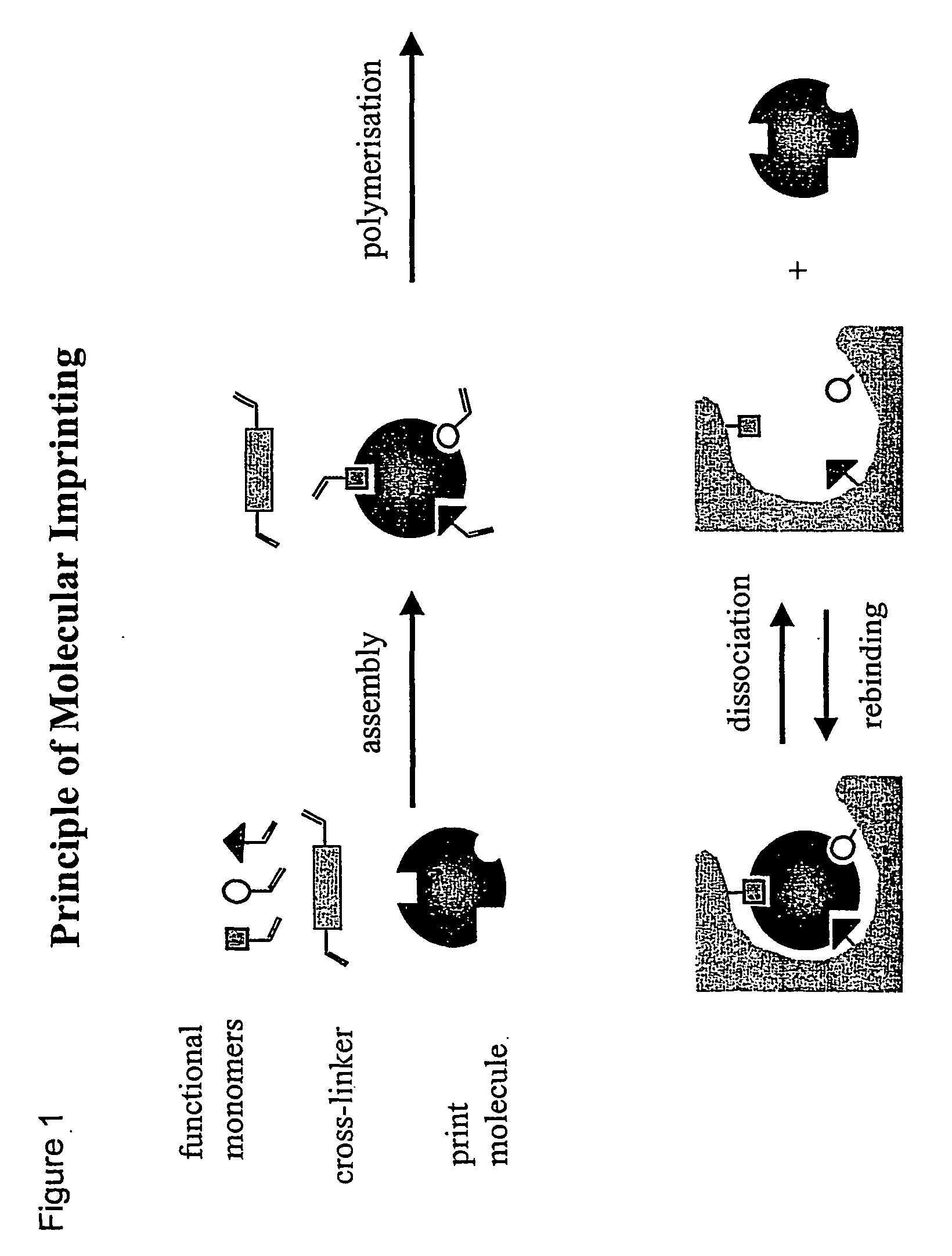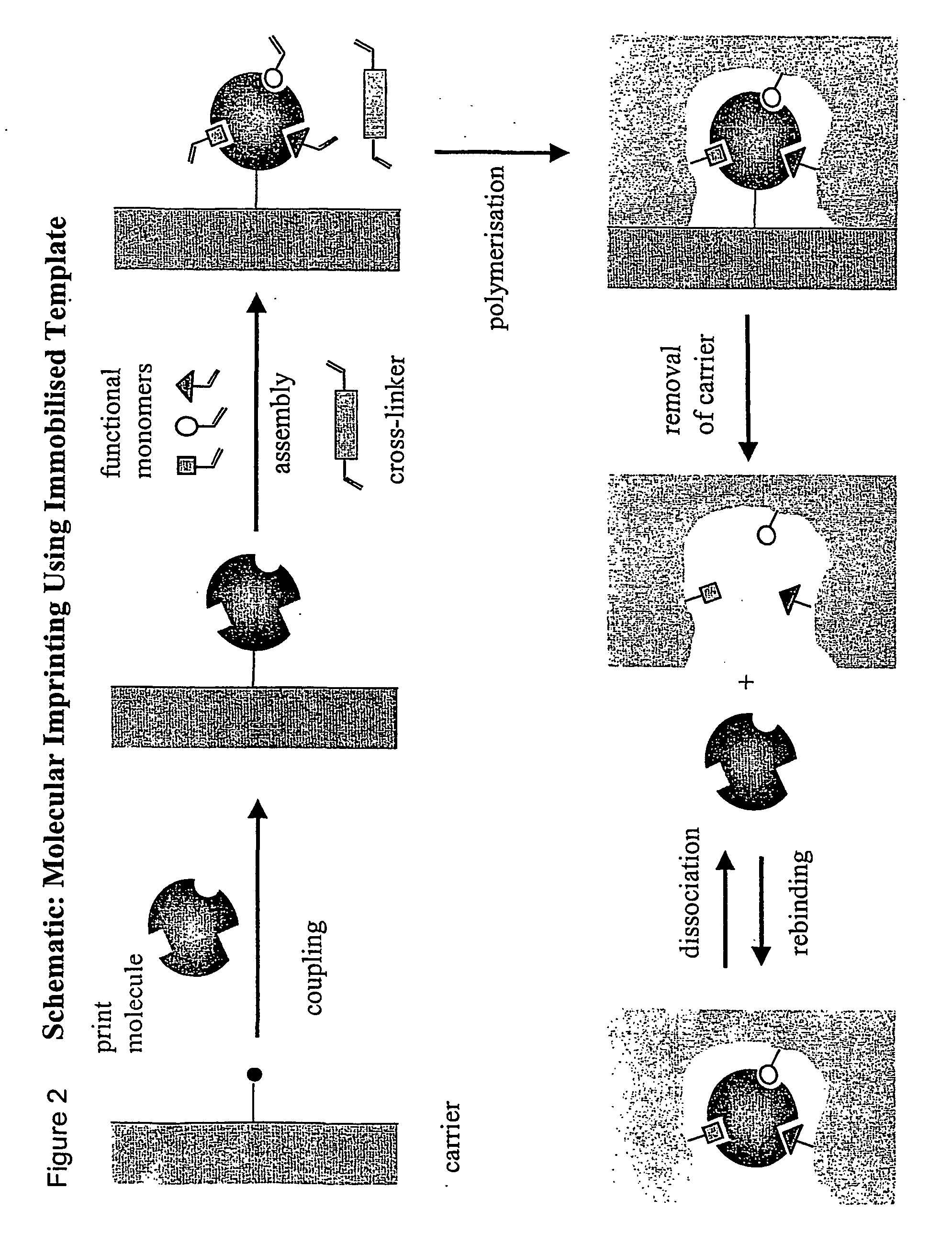Molecular imprinting
a technology of imprinting and molecular structure, applied in the field of molecular imprinting, can solve the problem of ensuring the heterogeneity of the binding site in the mip
- Summary
- Abstract
- Description
- Claims
- Application Information
AI Technical Summary
Benefits of technology
Problems solved by technology
Method used
Image
Examples
example 1
Immobilisation Onto Silica or Glass Surfaces
[0033] The template derivatised with a terminal silane functionality is chemically coupled to a silica or a glass surface using standard silanization protocols. Alternatively, the template or an appropriate derivative thereof is chemically coupled onto a functionalised silica or glass surface. Alternatively, the template or an appropriate derivative thereof is allowed to adsorb to a silica or a glass surface. Suitable monomers are then added and polymerised. After completed polymerisation the silica or glass support is removed using aqueous hydrofluoric acid aqueous tetremethylammonium hydroxide or concentrated sodium hydroxide, leaving behind the imprinted polymer. The silica or glass can be in the form of flat substrates, small non-porous particles, or porous beads. In the latter case, the polymer can be synthesised in the pores of the bead.
[0034] A more detailed recipe: The coupling of the template to the aminopropyl silica used as the ...
example 2
Immobilisation Onto Latex Beads
[0036] The template or a template derivative is chemically coupled or allowed to adsorb onto plain or functionalised latex particles. Suitable monomers are then added and polymerised. After polymerisation, the latex support together with the template is removed for example by extraction with hot toluene, leaving behind the imprinted polymer.
[0037] A more detailed recipe: Diaminohexane (DAH) was covalently coupled to carboxylated latex: To 0.5 g cleaned carboxylated latex (corresponding to 0.130 mmol carboxylic acid-groups on the surface) suspended in 5 ml water N-hydoxysuccinimide (NHS) (23 mg, 0.4 mmol) and ethylene-diamine carbodiimide (EDC) (153 mg, 0.65 mmol), each dissolved in 1 ml pure water were added, mixed and allowed to react for 10 min. To this mixture 2 ml of 1 M diamino-hexane solution (2 mmol) was added to give a total volume of approx. 10 ml. The whole mixture was vigorously shaken and allowed to react at least for 2 h at room temp. on a...
example 3
Immobilisation Onto Chitosan
[0042] The template or a template derivative is chemically coupled or allowed to adsorb onto plain or activated chitosan surface. Suitable monomers are then added and polymerised. After polymerisation, the chitosan support is removed together with the template for example by extraction with strong acid or base, leaving behind the imprinted polymer.
PUM
| Property | Measurement | Unit |
|---|---|---|
| Solubility (mass) | aaaaa | aaaaa |
| Shape | aaaaa | aaaaa |
| Time | aaaaa | aaaaa |
Abstract
Description
Claims
Application Information
 Login to View More
Login to View More - R&D
- Intellectual Property
- Life Sciences
- Materials
- Tech Scout
- Unparalleled Data Quality
- Higher Quality Content
- 60% Fewer Hallucinations
Browse by: Latest US Patents, China's latest patents, Technical Efficacy Thesaurus, Application Domain, Technology Topic, Popular Technical Reports.
© 2025 PatSnap. All rights reserved.Legal|Privacy policy|Modern Slavery Act Transparency Statement|Sitemap|About US| Contact US: help@patsnap.com



